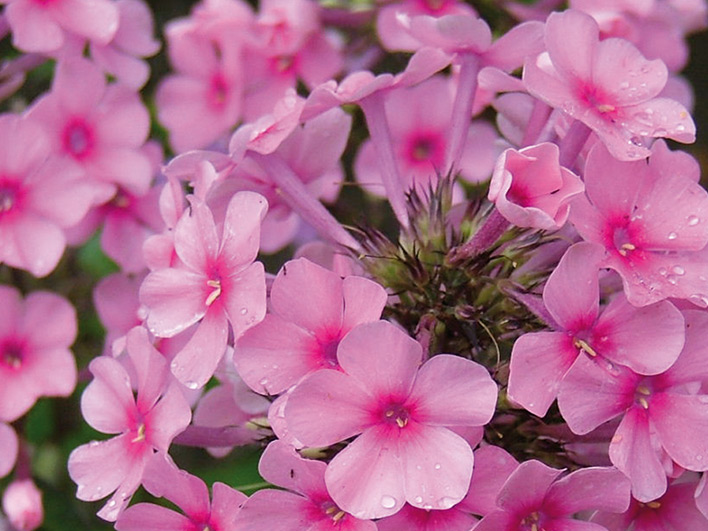Phlox Paniculata

The tall cottage garden phloxes are a joy in the border not only for their range of colours but also their scent.
The German plant breeder Karl Foerster said that “a garden without phlox is not only a sheer mistake, but a sin against the summer.” The colours can range from white, pink, mauve, deep purple to orange and red, many of them having a white ‘eye’. Some have more scent than others and this helps attract butterflies. The scent increases when the flowers are ready to pollinate, and then drops away when fertilised.
Hailing originally from Eastern North America where they thrive in good moist soil, apparently often at the edge of woodlands along the Ohio River, Phlox Paniculata was first introduced to the UK in 1732 by James Sherard. By the mid 1800s it was being bred in France and then Germany.
Phlox need good, fertile soil which is not too dry otherwise they will succumb to powdery mildew, and for profuse blooms they require sun to light shade and plenty of air around them.
Clumps can live for many years and are probably best divided occasionally in early Spring as growth starts, to keep their vigour. Apply bone meal in the planting hole, water well and mulch afterwards in order to retain moisture at the roots. If you are offered any plants it is very important to ensure they are not infected with eelworm which causes severe unsightly distortion of the stems and will infect phlox plants already growing in your garden. The only recourse is to burn them, but if the plant is particularly precious then root cuttings can be taken in winter, as eelworm only infects the stems.
These phlox bloom from July to August and are approximately 1M tall but some cultivars are taller. To increase flowering, the stems can be shortened by ⅓ to ½ in late May or early June. This produces a more compact plant with later flowers, but the flowering time can also be extended if say, only one in every three stems is shortened, leaving two stems at normal height which will flower at the usual time. This method is known as the Chelsea Chop.
Favourite paniculata phloxes:
Miss Pepper — myriads of small pink flowers with a darker pink eye. Very upright.
Blue Paradise — ranges from blue to mauve depending on the light during the day. Introduced by Piet Oudolf.
David — voted Plant of the Year in 2002 in USA. White. This was a chance seedling found near the Brandywine River Museum, in Pennsylvania, in 1991.
Le Mahdi — very deep eye-catching purple.
Starfire — glowing red flowers and dark leaves. Introduced by B. Ruys in 1937.
Hesperis — very tall, airy lilac-purple small scented flowers introduced by Coen Jansen, Holland.
July Tips:
01. Feed all garden plants early in the month with a general fertiliser.
02. Cut back hardy geraniums & centaureas for further flowers.
03. Cut back extension growths on rambling/climbing roses if growing out of place.
Claire Jenkins (MCIHort)
Bordervale Plants, Ystradowen, Cowbridge, CF71 7SX
01446 774036
Back to Readers CornerWe know our patients read the Village Directory, their feedback tells us that many use it as a valuable reference point for all local services and phone numbers as well as a great monthly read. We have found it invaluable in ensuring our name is seen — Kathryn LowryDavies & Lowry Optometrists